Anker SOLIX C1000 Review
An excellent medium-duty power station
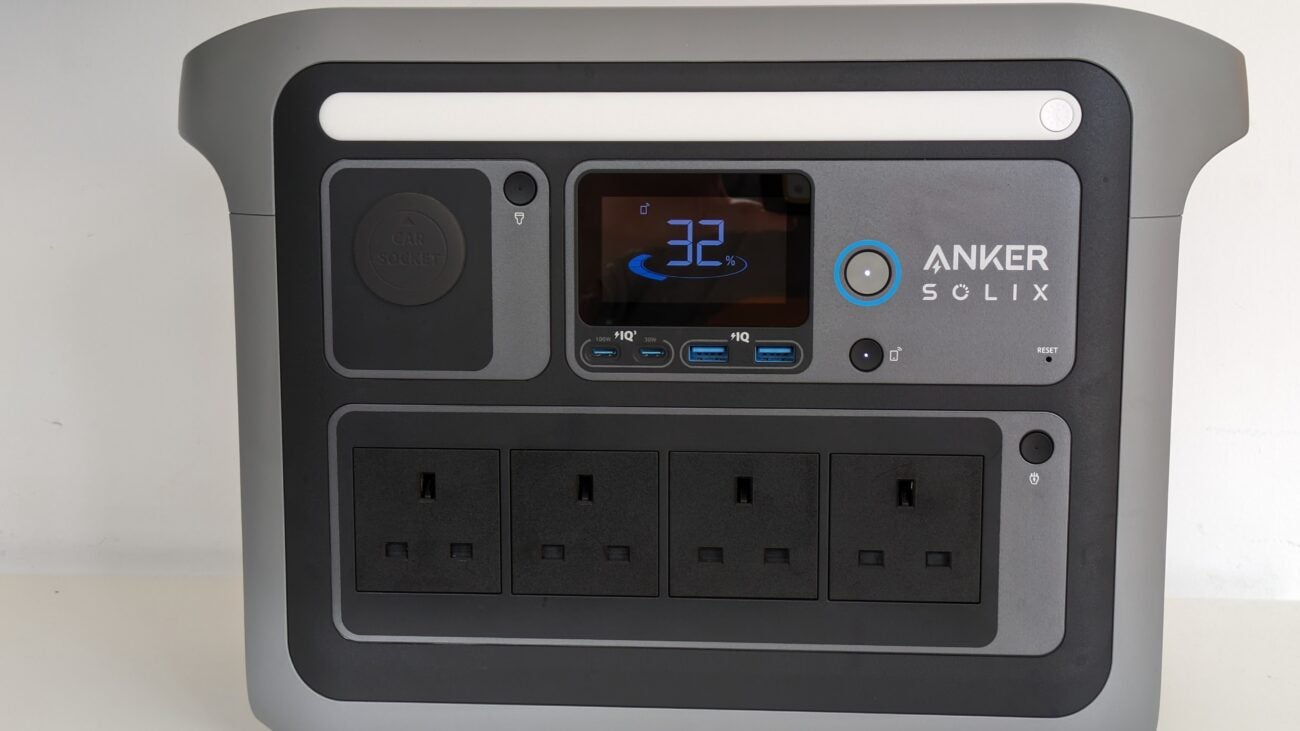
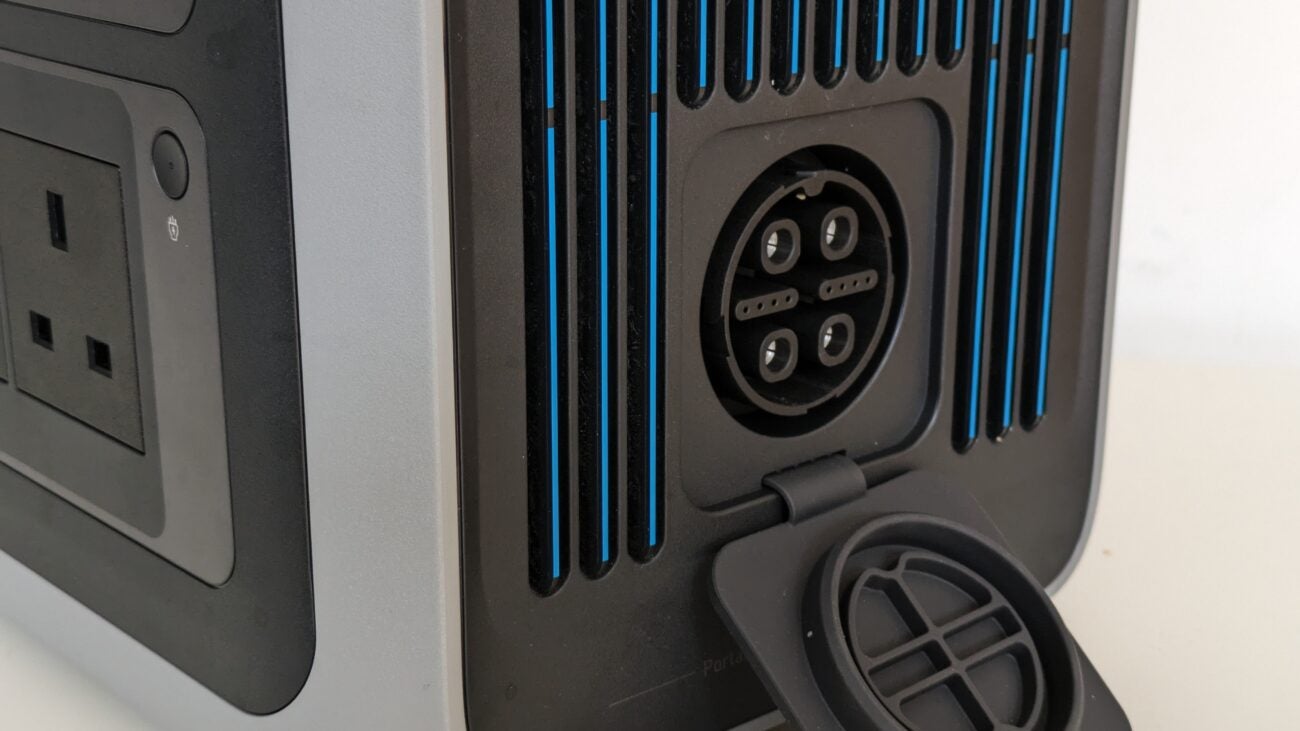
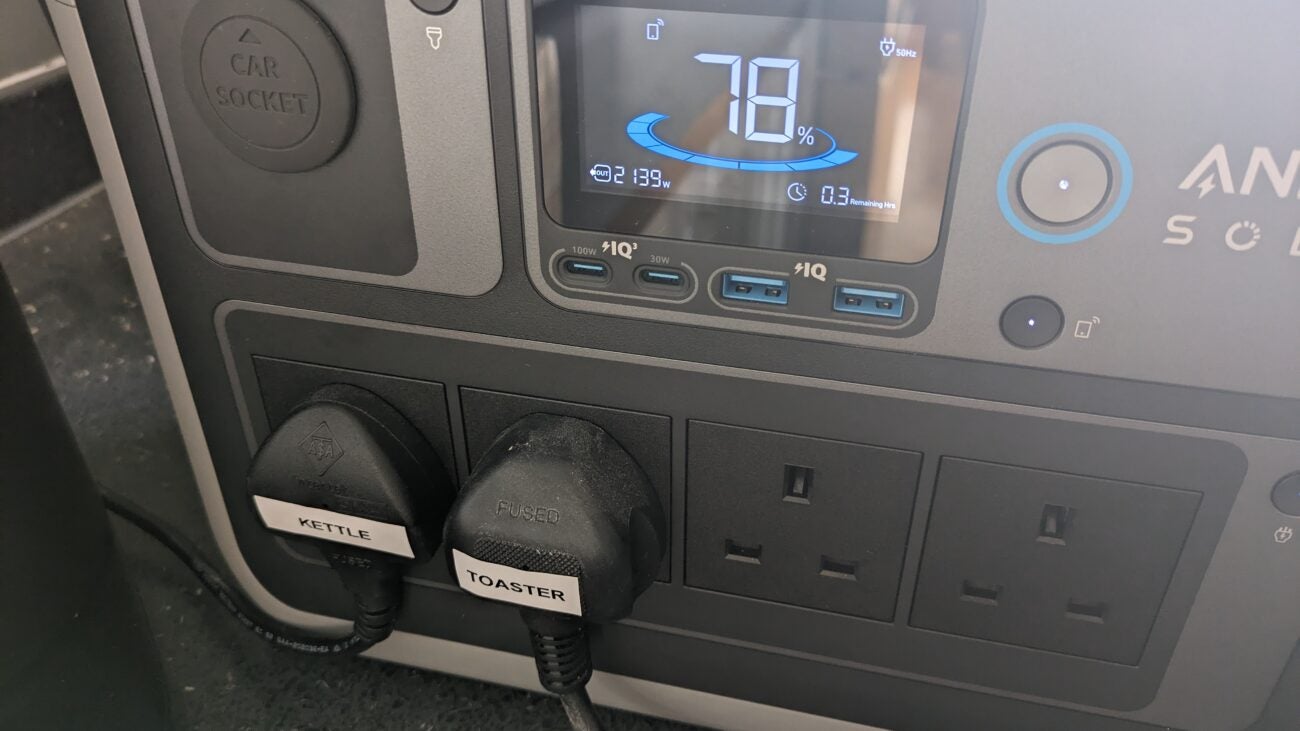

Verdict
The Anker SOLIX C1000 is a simply brilliant home power station. While it doesn’t have a huge amount of storage, its comparatively high power output means it can handle powerful devices such as some kettles, coffee machines and toasters. Yet somehow it’s packaged into a remarkably compact device, little bigger than we’d expect from a power bank with half the storage. It’s not the quietest choice, but it’s otherwise excellent for light to medium backup duties in the home.
Pros
- Excellent range of ports and functions
- Very compact for its capacity
- Extra configuration and control available through app
Cons
- Quite loud under full load
Key Features
- A medium-duty power stationThe Anker SOLIX C1000 can store more than a kilowatt hour of electricity, and provide backup electricity for reasonably powerful devices.
- A good range of ports and functionsWith four mains sockets, four USB sockets and a car charging port, the C1000 will power several devices on a camping trip, or in a power cut.
Introduction
The SOLIX C1000 is the latest battery power station from charging and power specialist Anker. It’s a medium-duty device rated at 1.8 kilowatts (kW), so it’s able to power anything from a mobile phone up to some lower-powered kettles, but at just over one kilowatt hour (kWh) its power storage isn’t especially big. That makes it ideal as a flexible home backup supply, but also not too hefty to take camping, where its storage is likely to be enough to keep phones, lights, computers and other equipment working for at least a weekend.
The C1000 offers some interesting features we haven’t seen on other Anker devices, including a HyperFlash charging mode claimed to get it from 0-100% power in 58 minutes. It’s also expandable with more storage, and built to handle surges up to 2.4kW – 33% more than its normal limit.
Like most modern battery power stations, this uses lithium ion phosphate (LFP) batteries, which have a longer service life and more stable chemistry than other lithium ion cells. The C1000 is designed to last 10 years and comes with a five-year warranty, so you can use it daily without worrying too much you’ll wear it out.
Design and features
- Amazingly compact
- Lots of ports for this size
- Rugged and reasonably mobile
The first thing you’ll notice about the Anker SOLIX C1000 is that it’s really quite compact for a power station with 1,056 watt hours (Wh) of battery storage. It’s significantly smaller and more portable than the Anker SOLIX F1200, and although it gives away almost 200Wh in storage, manages to cram in more ports and features. While the C1000 is unavoidably heavy, at 12.9kg it’s not too hard to lug it around the house, or a short distance to a camping site, although the Jackery Explorer 1000 Plus, which has slightly more capacity, is easier to carry because of its single large handle.
On the front panel, you’ll find four mains power ports, with a combined maximum power output of 1.8kW. That’s not enough to cope with, say, a washing machine, but it is enough for some modern kettles, and it’s certainly fine for most microwaves or toasters. In fact, the C1000 can power almost anything except heaters (or not for very long) and laundry appliances, so it could be a useful backup option if you’re subject to frequent power cuts.
This power station also has four USB ports, two of which are USB-A sockets rated at 12 watts. There are two USB-C ports, one rated for a rather tame 30W, but the other good for up to 100W charging. The final output is a 120W cigarette-lighter style car socket.
Also on the front panel you’ll find an LED strip light with three different brightness settings, plus an ‘SOS’ mode which actually flashes ‘SO’ repeatedly in Morse code. Like other Anker power stations, there’s a fairly big display which shows the battery charge state, together with any input and output power, and extra information such as whether any USB ports are supplying power.
The display tells you all you need to know about the C1000’s day-to-day operation, including giving a handy estimation of how long it’ll take to be discharged or recharged depending on the current loads and connections. However, the C1000 also supports Bluetooth and Wi-Fi connections, so you can also control it using the Anker app.
On its main screen, the app mirrors much of the display’s functions, but dig around and you’ll find quite a few more features. It’s here you’ll find the Ultra Fast Charging slider, which is the only way to enable the quickest mode. It’s also the only place to access other settings like the screen brightness and power timeout. The app also lets you download and apply firmware updates.
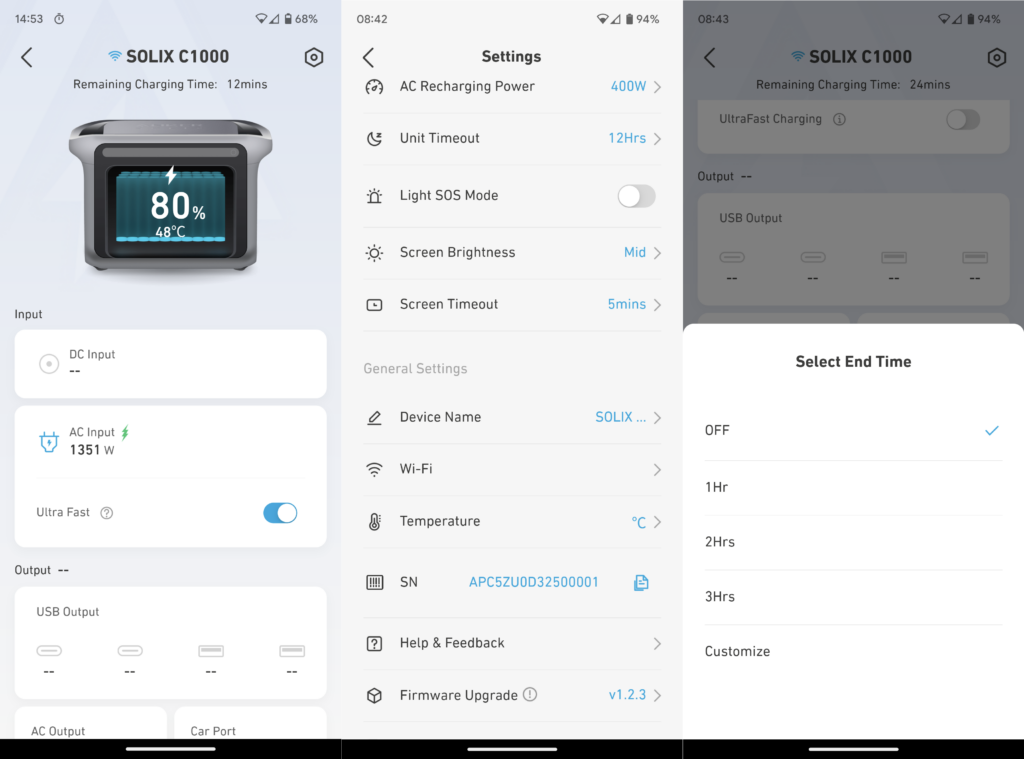
The C1000’s 1kWh of storage isn’t huge – it’s enough to power a fridge freezer for 12-24 hours, or run a few kitchen appliances for a day – but it has a trick up its sleeve. Prize open a rubber cover on the right hand panel and you can connect an optional, second 1,056Wh battery to double the storage – this wasn’t yet available to test at the time of our review.

Anker says its SOLIX power stations have a ‘drop-proof’ design, but we haven’t previously tested this claim. I unintentionally did so with the C1000 after losing my footing on the stairs and slamming it so hard into the wall that paint transferred to its rear panel. I couldn’t spot any actual damage, and the power station continued to work perfectly afterwards.
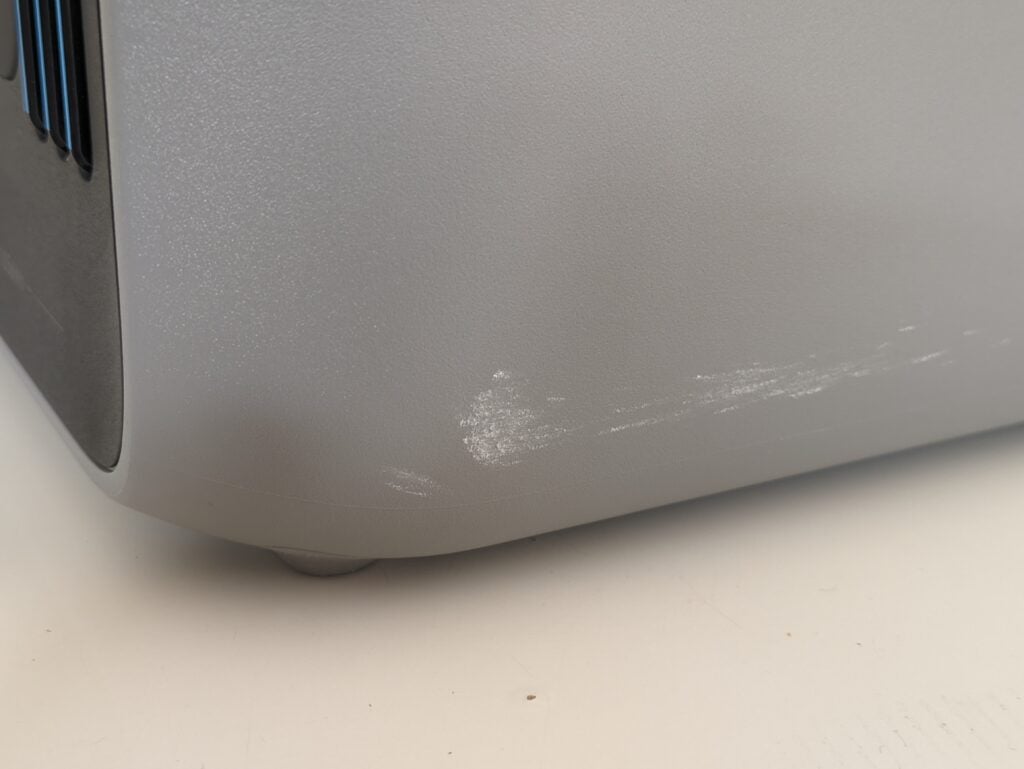
The Anker SOLIX C1000 offers bypass power, so it can charge happily while also providing power to any plugged in devices. You can use it as an uninterruptible power supply (UPS) for medical or electronic equipment. While its claimed 20 millisecond switchover time is longer than I’d expect from a dedicated UPS, it was quick enough that my test PC and NAS didn’t flinch when I turned the mains power off. One important thing to note is that, if you’re using the C1000 to power a CPAP or other essential medical device, you should disable the AC ports’ power-saving feature, which could otherwise turn them off automatically.
Charging
- Charge from mains, car, or the sun
- Maximum 1,300W input
- Very fast charging, even while providing power
If the C1000’s packaging is impressive, its recharging performance is even more so. Like many power stations, you can charge this one using mains electricity, solar power, or the output from a cigarette-lighter style car charging socket. You’ll find its AC input port on the left panel, alongside a reset switch and an XT-60 solar socket. This station comes with the necessary adaptors to connect a cable from a car, or from up to two portable solar panels.

The C1000 accepts up to 600W of solar power, which in ideal conditions would be enough to fully recharge it within two hours. However, at the maximum 120W output from a car, you’d need to drive for at least nine hours for a full recharge. One missed opportunity is that the C1000 can’t charge from the mains and a DC source at the same time, so you can’t use solar panels to speed up a charge, for example.
Not that you’re likely to need to. The C1000 can recharge at various power settings from 200W-1,000W, which you can select via the app. The top setting is as fast as you’d want to go in everyday use, while the lower settings are useful if you’ve only got access to a limited amount of power, for example an electric hookup in a campsite.
I exhausted the C1000’s battery and charged it from mains power using its 1,000W setting. It recharged in just under 90 minutes, consuming a little more than 1.1kWh. Assuming its battery went from fully empty to fully charged, that’s an efficiency of 92.8%. The C1000 was a little less efficient when recharging at the minimum 200W, or at 500W, consuming 1.3kWh and 1.2kWh respectively.
Ninety minutes is quick enough, but activate Ultra Fast charging through the app and the C1000 charges at up to 1,300W. At this setting, it got from 0-80% battery in just 42 minutes, and went on to hit full charge in 54 minutes – four minutes quicker than Anker claims. Anker says ‘Normal charging is the best way to protect the battery’, which suggests you should save ultra-fast charges for when you really need them. It’s certainly a little less efficient, and involves louder fan noise than slower charge rates.
Performance
- Stable power output
- Excellent efficiency, especially over USB
- Loud fans on heavy load
With a decent, 1.8kW maximum power output, I subjected the C1000 to a couple of challenging tests. It could happily power my kettle – also rated at 1.8kW – my microwave, or my toaster, but not more than one of them at the same time. At one point I forgot and set the toaster to single-slice mode while making tea. I had time to get my phone out and snatch a photo before the C1000 powered itself down gracefully. It was happy to restart about 15 seconds later.

With the C1000 fully charged I connected it to my electric car’s ‘granny’ lead, which has a standard UK plug. I set this to 8A, roughly equivalent to this power station’s maximum 1.8kW output, then waited. Although it only added an indicated 1% to my car’s 64kWh battery, it remained stable for the 36 minutes it took to fully discharge.

The C1000 certainly seemed comfortable with anything up to and including its limits, but its compact packaging does give rise to my only significant criticism: its small fans are slightly harsh, and quite loud as the station begins to approach its maximum AC load. That said, they’re quite measured at moderate outputs, such as the 1.2kW my microwave consumes at full power.
I used an AC power meter to measure the amount of power supplied at various loads. When charging the car, the C1000 provided 0.87kWh. Assuming the battery went from fully charged to fully drained, that’s a good efficiency of 82%. With a constant 200W load, the C1000 provided 0.89kWh (84.2%), and with a middling 750W load it reached an excellent 0.95kWh (89.8%). Typically for a power bank, the C1000 was most impressive when providing DC power over USB. I connected a constant 60W load and measured very nearly 1kWh of output, an efficiency of 94.4%.
These are good figures, but like the charging efficiency quoted above they rely on the assumption that the battery goes between fully charged and fully spent. You’ll get a more accurate round-trip efficiency by comparing the energy you put in directly against what you got out. Using my best figures, the C1000 managed a round-trip efficiency of 87.6% when charged via AC then discharged via USB. It managed 83.3% for AC charging and discharging. These are among the best performances I’ve measured.
We provide an indication of a power station’s value by dividing its price by how much electricity it can store in its lifetime. Anker says the SOLIX C1000 is rated at 1,056Wh, and will retain at least 80% of this after 3,000 full charge/discharge cycles. In theory this means it could store 3,168kWh, which works out at a reasonable 32p per kWh stored if you buy it full price. However, we’ve already seen the C1000 discounted by as much as £250. Snap it up at nearer £750 and it offers a very competitive 24p per kWh.
Latest deals
Should you buy it?
A brilliant, mid-range power station
This is an excellent power supply for medium-duty backup around the home, or if you plan to take higher power gadgets like a coffee maker on a camping trip. It’s brilliantly packaged and surprisingly compact, particularly when you consider its impressive charging and output performance.
Not powerful enough for everything
The C1000 doesn’t have the chops to power laundry appliances or dishwashers, and its 1kW storage is a bit light if you want a do-anything backup power supply. It’s also quite noisy when working hard.
Final Thoughts
The SOLIX C1000 feels like a small but significant step forward for relatively affordable, moderately powerful power stations. It’s quite small and portable, yet it offers a decent output and stores a fair amount of power – you can always expand it if you need more.
Anker’s power station screens are well designed, but adding Wi-Fi connectivity makes it easy to get the most from the C1000, giving power users the chance to tweak performance and monitor the station from anywhere they like. And underneath it all there’s a great power supply, offering good efficiency and stable performance across the range of scenarios I tested. Spend a little more on the Jackery Explorer 1000 Plus and you don’t get the UPS features, but you get more capacity, and a slightly higher input, plus a device that’s a touch easier to carry around.
How we test
We test every battery station we review thoroughly over an extended period of time. We use standard tests to compare features properly. We’ll always tell you what we find. We never, ever, accept money to review a product.
Find out more about how we test in our ethics policy.
We test with a variety of devices to see how long the battery will last.
We test different charging methods to see how quickly the battery can be topped up.
FAQs
The C1000 uses long-life LiFePO4 batteries, which ought to last for thousands of cycles. Anker says it’s designed for a 10-year lifespan, and that after 3,000 full charge/discharge cycles you’ll still have 80% of the batteries’ original capacity. It back this all up with a generous five-year warranty, so the C1000 ought to be a safe investment.
Like other Anker power stations, the C1000 gets a five-year warranty.








